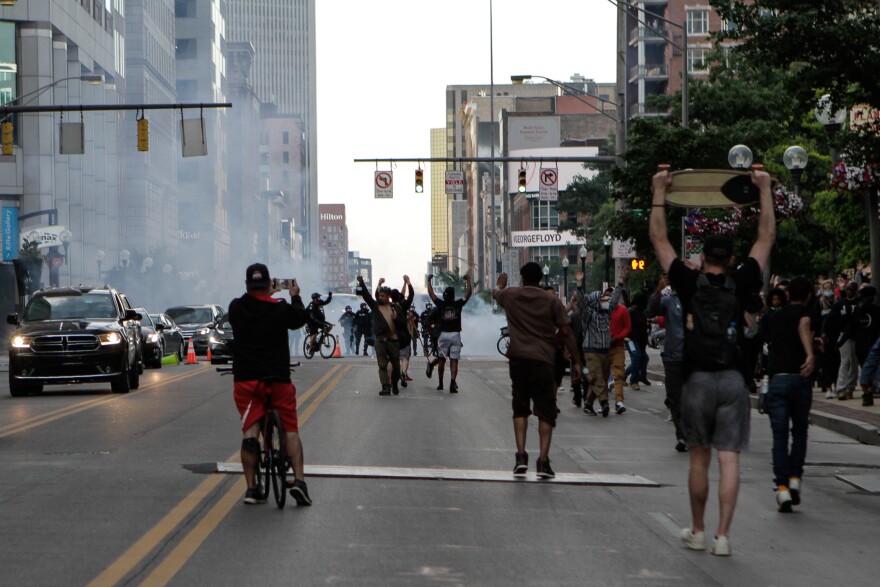Hours ahead of the city's second night of curfew, Columbus Police deployed tear gas on protesters and blocked off streets downtown.
The city of Columbus announced Sunday afternoon that the 10 p.m. curfew would remain in place until 6 a.m. Monday.
Police are blocking high street. There are armed officers on the roof of the courthouse as well. It seems like they are waiting for curfew to take effect. People have largely cleared the streets.
— Paige Southwick Pfleger (@PaigePfleger)
After a day of nonviolent protests over the killing of George Floyd by Minneapolis Police, Columbus demonstrators converged near Broad and High Streets for the fourth night in a row.
Law enforcement were mostly absent from the early protests, which remained relatively peaceful even as hundreds of peopleãwearing makeshift masks and carrying signsãcrowded in the streets.

ãI came out here today to protest the deaths of George Floyd and other black men across America," said protester Kierstin Ivory. "I seen the video and I just couldnãt sleep at night. It made me feel very uncomfortable, and I felt like I needed to go out and do my part and protest peacefully.ã
Ivory said it was her first day out protesting, and she planned to return every day there is a protest going on.
ãWe donãt need police officers shooting pepper spray at us and coming at us with violence if all weãre doing is promoting justice," Ivory said.
Another protester, Carlton Moris, said he was inspired to come out after seeing videos of Columbus Police clashing with protestors.
"Well, Iãd been weighing it the last couple of days," he said. "But then obviously seeing the videos of the Columbus Police in riot gear and the way they were pushing back on protesters and demonizing protesters who were trying to perform peaceful protest - I got scared, I will admit that - but today I was sick of it. I was like, ãToday, Iãm going.ã"

Many in the crowd were intent on keeping the environment calm, although some demonstrators clashed with drivers in cars, including one who appeared to try and drive into a group of people.
Just before 8 p.m., hours before the curfew was set to begin, Columbus Police arrived and warned crowds to disperse immediately. The crowd raised their arms and chanted, "hands up, don't shoot."
Some protesters threw water bottles at the officers, who fired wooden projectiles back into the crowds. Authorities then deployed tear gas at the intersection, causing protesters to scatter for cover.
Protestors were raising their arms. Police warned protestors to disperse. Water bottles were thrown then the police fired back.
— Paige Southwick Pfleger (@PaigePfleger)
Dispersed protesters sat on benches at the Ohio Statehouse. People walked around offering milk or water. Protester Aaron Besco's eyes were red from the gas and from crying.
"Some dude got shot by a rubber bullet, so I had some gauze and was trying to help him. Then I got teargassed in my face," he said, crying. "Why would they do that?"

While continuing to release tear gas, police with bicycles and gas masks blocked sidewalks along High Street, pushing people south. Officers from the Franklin County Sheriff's Office have barricaded several streets.
In front of the Statehouse, a few Ohio State Highway Patrol troopers, who were Saturday by Gov. Mike DeWine to help with law enforcement in Franklin County, donned gas masks.
Curfews have also been set in Cincinnati, Dayton, Cleveland and other cities.
Columbus Police have come under heavy criticism for their actions during recent demonstrations. On Saturday afternoon, officers at the Statehouse used tear gas and pepper spray on crowds that included U.S. Rep. Joyce Beatty (D-Ohio) and Columbus City Council Shannon Hardin, both of whom are African American.
"Some of what we saw yesterday from Columbus Police was aggressive," Mayor Andrew Ginther said in a that has since been deleted. "We are proactively addressing these incidents. The goal is to find a better balance between public safety and peaceful protest. We will also work more swiftly to bring about change and reform."

When questioned about his comment, Ginther added, "proactive as in no one needs to file a complaint with Internal Affairs. We are investigating."
In a Saturday, Fraternal Order of Police president Keith Farrell criticized what he called the "negative characterization" of Columbus Police by Ginther.
"Officers feel as if their hands are being tied by the Mayor and his administration," Farrell wrote. "There is no reason rioters should be permitted to destroy and loot business."
Over the weekend, Hardin and several other City Council members also indicated their support for police reforms. In a statement Sunday, Council president pro tem Elizabeth Brown criticized "heavy-handed aggression by police" against demonstrators.
"With urgency we must form a Civilian Review Commission, greatly expand deescalation training including use of non-aggressive tactics during nonviolent protest, adopt tighter restrictions on officer use of force, and implement the recommendations of the Safety Advisory Commission," Brown wrote.
If we want both peace and justice, we need to change the system. PJPãs demands will require action from the Mayor, Chief Quinlan, and City Council. Iãm a YES on all measures that require my vote.
— Elizabeth Brown (@lizforus)
Hardin called for similar changes, including independent investigations into police use of force, which community activists have demanded for years. He also urged the implementation of recommendations from a on racial disparities in Columbus Police procedures.
This article will be updated with more information as the story develops.






